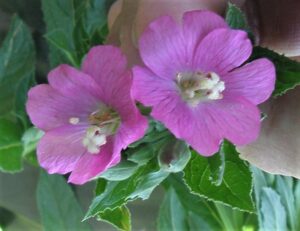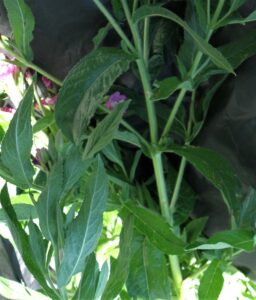Hairy willowherb, codlins and cream
Epilobium hirsutum
Epilobium hirsutum
“These delicate flowers are ones to get a notebook and draw a picture. The beautiful color and the uniqueness that is captured as the seeds disperse is one to grab your camera and take a picture.” (NC State Extension) Despite its invasive tendencies, this plant is often used as an ornamental.
Hairy willowherb was first reported in Newport, Rhode Island in 1829. It is a member of the Evening primrose family (Onagraceae). The Evening primrose family is distinguished by having flowers that are 4 separate petals and 4 separate sepals.
A perennial, Hairy willowherb can grow up to 6 feet tall. The plant is covered with fine hairs. The leaves look like those of a willow, therefore the name “willowherb.” The flowers are very showy, rose to purple color. They have notched petals with white centers and creamy white stigmas. The fruit has silky white hairs with small seeds attached.
Hairy willowherb reproduces by rhizomes, seeds or fragments of the plant transported from one area to another. One plant can produce up to 70,000 seeds per growing season. In the event that there are not natural pollinators available, Hairy willowherb is capable of self-pollinating.
Because this plant is semi-aquatic, it can survive changing water levels: when roots are submerged, they develop aerenchyma tissue (contains air spaces to hold oxygen) to allow the exchange of oxygen between roots and the upper part of the plant.
All of these factors allow Hairy willowherb to aggressively inhabit new wetland areas. These infestations prevent native plant species from thriving and chokes water flow.
Several years of consistent control is needed to be successful with eradication.




